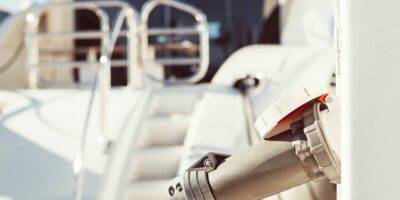Mounting A Trolling Motor
You can mount a trolling motor on a boat with a bow rail, if you do a little planning first. Here is a step-by-step process on how to do so.
- January 29, 2024
Bow-mounted electric trolling motors are practically required equipment aboard many trailerable fishing boats. Pulling rather than pushing the boat with power that exceeds 100 pounds of thrust on some models, a trolling motor permits quick, precise maneuverability that is nearly silent, which is appreciated by anglers and wildlife watchers alike.
The motors are stowed flat on the forward deck atop integrated mounts and flipped over the bow into a vertical position with the motor head in the water when deployed. That portable flip-up/down design is perfect for boats with flat, open bows, but not so much for owners of boats with bow rails and angles up front. Our project boat carries both features. Here’s how we faced them when installing a Minn Kota RipTide ST, which features a quick-release bracket onto which the motor’s base can be secured.
The motor’s mounting pad must be horizontal to the water. To achieve that on this boat, a mounting plate had to be fabricated to compensate for the angled edge of the bow deck. We used a piece of aluminum diamond plate bent into a “V” at the proper angle and secured to the deck with stainless steel bolts and an aluminum backing plate (see photo 2). You can skip this process if your boat has a flat bow area suitable for the motor’s mounting pad.
The bow rail presents a tougher problem because it prevents the motor from being able to flip from the horizontal (stowed) to the vertical (operating) position. We didn’t want to remove the bow rail to accommodate the electric motor and came up with a solution that allowed us to retain the rail.
STEP 1
Deciding Where to Mount Motor
Hold the motor in the operating position to get an idea of where to mount the base pad on the bow.
STEP 2
Marking the Location for the Plate Supporting the Mounting Pad
Mark the location for the plate supporting the mounting pad and secure it to the deck.
STEP 3
Where Will the Shaft Pass Through the Bow Rail and Mark
Secure the motor in the quick-release pad to determine where the shaft will have to pass through the bow rail when being stowed and deployed, and mark.
STEP 4
Cutting Out a Section of Bow Rail
Cut out the section of bow rail that interferes with the motor’s shaft. In our case, we removed about a three-inch section.
STEP 5
Drilling Holes for Quick Release Pins
Using a section of stainless steel tubing one size larger in diameter than the bow rail, measure and cut a piece long enough to bridge the gap while sheathing at least two inches of the original railing on either side of the gap. Our bow rail is made of 7/8-inch tubing and 1/8-inch length of 1-inch-diameter tube provided a snug yet easy-to-slide fit over the remaining rail sections.
STEP 6
Measuring and Cutting Railing
Center the tube over the gap and drill 1/4-inch holes for quick-release ring pins used to secure the sleeve in the closed position.
STEP 7
Sliding Sleeve Open
Slide the sleeve to the open position and drill one more hole to allow it to be secured with a pin on the open position when deploying the motor.
STEP 8
Inserting Quick Release Pins
Insert quick-release pins in each position to make sure the holes line up and the sleeve is secure in both.
STEP 9
Testing Deploy and Stow Process
Place the motor on the pad and test the deploy-and-stow process.
Note: If the motor will obscure your bow light, remove it if you are underway after dark.
Dan Armitage
Contributing Editor, BoatUS Magazine
About Vessel Vanguard
Vessel Vanguard is a leading marine safety and maintenance management software provider dedicated to revolutionizing the maritime industry. With a commitment to innovation and excellence, Vessel Vanguard delivers cutting-edge solutions to streamline operations and enhance vessel performance and safety.
Latest Industry Insights

Embracing E-Boating Efficiencies

Boat Fuel Systems

The Future of Boats & Boating

Yacht Navigation Light Inspection
View All of Our Industry Insights
Navigate maritime with the latest news, practical how-to guides, insightful analyses and more.
